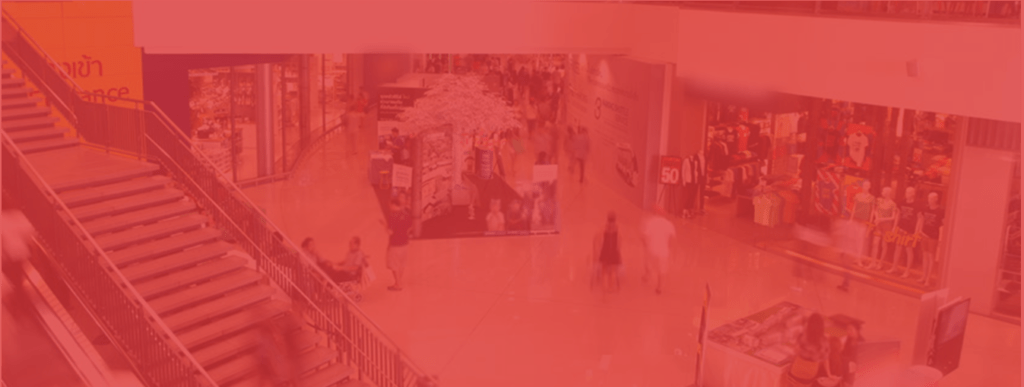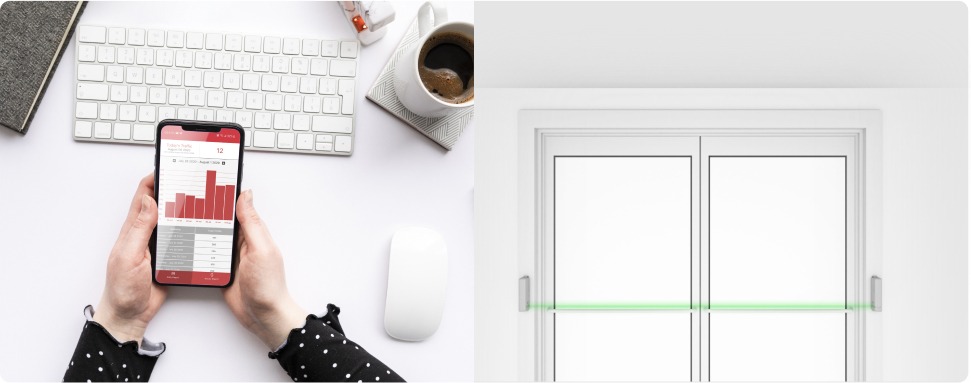So, you’ve done your research to understand the benefits of people counting, and you’ve decided to integrate a modern foot traffic system to your establishment. Or, perhaps, you’ve leveraged people counting in the past, but your current system is now beyond its prime. In any case, there is a wide array of people counting options to choose from.
Like many products and services today, the luxury of choice can rapidly turn into information overload. The following article will help you target the right questions to ask when picking the optimal new people counting solution.
It breaks down the 10 overarching questions into key points to make your shopping process as easy as 1, 2, 3!
Content
1. What is the accuracy level of the foot traffic counter?
2. How easy is it to install the people counting device?
3. What are the specifications of the physical environment?
4. Can the people counting system adapt to different situations?
5. Can the people counting system be scaled up?
6. What are the shopper counting system’s reporting abilities?
7. Is your foot traffic data protected?
8. The “new normal” (COVID-19): can the people counter help control occupancy?
9. Does the footfall solution provider offer expert support?
10. What is the actual cost of the visitor counting system?

1. What is the accuracy level of the foot traffic counter?
Footfall counters are a powerful instrument to optimize strategies and grow business. Yet your data-based decision-making will only be as good as the quality of the data you work with; not all people counters are born equal!
Accuracy is, of course, a priority. But there’s more. Your people counter should also provide consistent results. Some brands may boast, for instance, of 90% accuracy levels for their devices when, in fact, the consistency of this performance varies significantly, creating peaks and valleys in the numbers collected, which later translates into data you simply can’t trust. The takeaway? Think (Accuracy X Consistency) = Data you can rely on.
With this in mind, we recommend focusing on two optimal types of people counters: wireless beam devices and 3D camera devices. Though interesting, thermal counting devices have glaring flaws; someone merely walking in with a coffee can trigger the system, for instance. Regular, single-lens camera systems, on the other hand, are more affected by changing light conditions, including sunlight, which means they may count shadows.
A potent beam people counter can deliver accurate and consistent footfall data for both small and wide entrances (up to 15 ft). Storetraffic’s wireless PEARL people counter, for example, is an optimal solution for 3 ft to 6 ft outward opening doors and low to medium traffic. A smart and low-cost beam people counter may also filter carts and children, while also splitting the number of entries and exits.
When granted with long-range sensitivity, a wireless beam door counter also works in wider entrances, where more than one 3D camera might be needed. In larger entryways however, if more than one person “breaks the signal” at the same moment, beam sensors will only count one entry. Since visitor traffic in buildings with such wide entrances is often based on patterns, a top-quality beam counter will deliver valuable insights nonetheless, providing consistent traffic pattern indications that can readily be connected to other KPIs.

More expensive and sophisticated, 3D camera devices are designed to tackle challenging scenarios, such as rotating doors, multiple count lines, and dense crowds moving through entryways. Ceiling-mounted, advanced people counting cameras like the 3D Scope II LC are 99% accurate in any kind of situation—where a beam counter might drop to 85% if more than one person crosses the sensor at a given moment. Storetraffic’s 3D Scope II LC camera covers entries up to 26.2 ft (8 m), the largest field of view on the market. Need to scope out a more massive entrance? The system can handle a network of connected cameras.
2. How easy is it to install the people counting device?
Moving forward with a competitive people counter system for your location is an exciting prospect. Can’t wait to get started? Hold on! Have you also considered installation requirements?
Any kind of camera-based system or wired people counter will be more challenging to install. You’ll likely need the professional technical support to run cables through walls and ceilings, perhaps even to install a new power outlet.
Requiring less energy, beam counters can run on batteries and be entirely wireless, greatly facilitating installation. Storetraffic’s PEARL wireless door counter is a good example. The system’s plug-and-play design makes it a self-install Wi-Fi people counting solution you can set up in minutes, with zero installation fees; and it still delivers your traffic data directly to your computer or smartphone.
3. What are the specifications of the physical environment?
Taking into account the inherent physical characteristics of the footfall area is essential: width and type of door, foot traffic density, lighting conditions, wiring possibilities, all are aspects you’ll want to consider.

Door type
As stated, 3 ft to 6 ft outward opening doors—whether single or double—are a perfect fit for a wireless door-mounted beam people counter like PEARL. When choosing a reliable and proof-tested system, this cost-efficient solution will provide winning results. A consistent beam system may perform well in larger entrances as well, albeit with an analytical focus on traffic patterns, rather than absolute numbers. 3D camera devices can handle any type of door, whether outward or inward opening, even rotating. They’ll also provide on-the-money footfall numbers for larger doorways, though multiple cameras may be required if the entrance is huge. Want to count people outside, walking by your door? The 3D Scope II LC camera can do this too.

Light

Traffic Density
If many people routinely walk into your location at the same time, an overhead traffic sensor (3D camera) would be the right choice. As mentioned, wireless door counters are optimal for most entrances with low to medium foot traffic. If people often linger in your entrance—e.g. a mall store with tables or displays adjacent to the lease line—make sure they don’t trigger the people counter’s beam signal, however. In which case, a 3D camera will be a safer choice.

Wiring
Most overhead camera sensors use Cat 5 cables, which provide both Internet connectivity and power—they are also known as PoE (Power over Ethernet). Your current network of wires for power and Internet connectivity could weigh in on your decision. If you prefer a plug-and-play solution—or if you decide that wiring procedures simply aren’t an option for your location—then a wireless, beam footfall counter is a go-to option.
4. Can the people counting system adapt to different situations?
Whichever the technology you choose, you’ll want to make sure the people counting system has your back in case of a power outage or loss of Internet connection. Fail-safe technology separates today’s leading people counting contenders from yesterday’s pretenders. Both PEARL and 3D Scope II LC come with a built-in battery. Their permanent memory capability will also store your data and upload it to the server once everything is powered up again. They’ll also alert you, should you be off-site.

Fail-safe
Clearly understanding your goals in terms of foot traffic data is also crucial. Both beam and 3D camera devices will provide valuable visitor stream data to understand your actual business potential, measure conversion rates, and assess performance. Aiming to track visitor movement within your location? You’ll need multiple 3D cameras for that. Want to get creative? Wireless door counters work in many types of doors (e.g., changing rooms)—some have even leveraged their counting abilities in surprising applications.
Word of caution: be wary of ever-expanding data collection possibilities. Some systems, for instance, will go as far as breaking down your demographics—these systems will require add-ons or additional cameras. Projects get more expensive as the segments of data collected increase; too much data can actually translate into less actionable insights, due to overwhelming foot traffic analysis.

Your Real Data Needs
Your footfall data is precisely that: it’s yours. Make sure you can access and download your data at any time and in any format that suits you (PDF, API, Excel, Raw, Flat file, etc.). Data should be centrally reported to enable key players in your organization to access the information through a cloud-based or in-house server connection. Some systems’ advanced footfall software, like Storetraffic’s T.M.A.S. platform, will also feature an all-in-one dashboard with multiple report and language options.

Data For Today’s Market
5. Can the people counting system be scaled up?
When it comes to choosing a people counting system, ask for a solution that will stand the test of time.
Should you add counters within the same brick-and-mortar location—or in various locations for that matter—make sure the system is capable of connecting and configuring all sensors through a centralized platform. Storetraffic’s exclusive, free iOS & Android App offers control over as many devices and locations as you wish. So does the full-suite T.M.A.S. platform, with the added benefit of multi-user access.
Consequently, focus on foot traffic solutions that offer business intelligence data processing from the get-go. Enquire about the provider’s plans for updates and new developments. Can a scaled-up system enable you to break down the data per period, store, region? You’ll still want to draw data from specific sensors too, or you may want a global foot traffic picture.

6. What are the shopper counting system’s reporting abilities?
People counting systems worthy of your consideration must go beyond the collection of footfall analysis data. To get the full competitive advantage, seek a powerful combination of quality visitor traffic sensors AND quality data reporting, that will provide you with actionable insights.
Make sure the foot traffic system you pick provides automatic synchronization of data, with frequent updates; every hour or less is a good benchmark. You’ll want to be able to download reports as well, to reap the full benefits of footfall analysis. Scheduled reports delivered directly to your inbox is also a great option to have.
Whether through app, dedicated software, or web-based software access, remember that the foot traffic counting solution should provide you with a one-stop, centralized platform. Think of it as your dashboard or personalized information hub—make sure it’s continuously serviced and adequately updated as well.
This interface must be user-friendly and accessible at any time and from anywhere. Are you looking for multi-user access? Storetraffic’s T.M.A.S. offers this. The platform should also provide you with standard and customizable reporting features to help you evaluate potential scenarios and optimize decision-making.
Seek a foot traffic system that quickly connects with other key metrics and IT solutions you currently use or plan to use, from sales to staff scheduling—a must if yours is a service-sensitive business—peak periods and more.
A system with optimized reporting and updated capabilities will let you assess your performance quickly and efficiently, so you and your team can react swiftly and strategically. If you’re going to truly leverage people counting solutions in today’s fast-paced environment, steer clear of systems that don’t offer this level of BI (business intelligence) integration.
7. Is your foot traffic data protected?
Many elements determine the global safety score of a people counting system.
First off, can the hardware—i.e., the actual counter—be tampered with? You don’t want someone with too much time on their hands to “play with” or pull out the sensors. Some counters also make it possible for store employees to artificially boost or cut down on the number of people entering. Both are signs of antiquated technology.
Likewise, look for counters with a built-in battery and internal memory in case of a power or Internet outage. A quality people counter will also alert you automatically if a problem like low power or a blocked signal arises. Your footfall data must also be hosted on a secure cloud space with long-lasting storage, using an encrypted communication protocol between the counter and the server, as well as between the users and the server.
8. The “new normal” (COVID-19): can the people counter help control occupancy?

Did you know that some people counting solutions can also serve as a control & compliance occupancy solution?
2020’s COVID-19 outbreak—and the collective fight against it—have placed a new responsibility on retailers, i.e., the live monitoring of building occupancy to ensure that mandatory social distancing/physical distancing measures are respected.
Such measures will come and go, following the progression of COVID-19, or a future virus, hence in part the notion of a “new normal.” When choosing a people counter, look for a solution that can go beyond foot traffic numbers as KPIs; ask for a system that also allows the option of live occupancy tracking, if and when you need it.
A people counter system with a live occupancy feature should facilitate API calls. Foot traffic numbers will then be refreshed every few seconds and displayed on your user interface. A potent system should also come with an App that lets employees, security guards, and managers access the occupancy numbers simultaneously. Furthermore, the system must also allow the monitoring of traffic flow, whether on- or off-site, to ensure a single store or multiple stores are all safely complying with the maximum occupancy numbers instructed by authorities.
Both PEARL and 3D SCOPE II LC solutions by Storetraffic readily allow for live building occupancy monitoring. The PEARL beam people counter is best suited for controlled, one by one entry and exit, while the 3D SCOPE II LC Camera can handle side-by-side walk-ins, groups, or large crowds with little to no monitoring.
9. Does the footfall solution provider offer expert support?
Post-purchase customer service can be just as important as the buying experience. Faced with issues, you’ll want to be able to count on your people counter provider’s support and a rapid response time, either through email, live chat, or phone. Otherwise, you could risk losing weeks of data.
Expert levels of support also concern installation and configuration. Recommendations on how to train your employees and on best people counting practices are giveaways of a quality and holistic approach to people counting service. Storetraffic’s people-first approach, for instance, translates into a host of services, no matter the size or the scope of its client, including free demos, installation experts, satisfaction policy and post-purchase technical and strategic support.


10. What is the actual cost of the visitor counting system?
A more affordable people traffic counter could end up costing you more. Look beyond the upfront, advertised cost.
What about hidden fees? Is the shipping covered, and are all accessories, covers, and adaptors included? Storetraffic, for example, abides by a one-price-includes-all pricing policy.
Be sure the installation requirements echo your budget. Are you looking for a self-install system like the PEARL traffic counter? Is the wiring process required by a camera-based system a deal-breaker? Maintenance and reliability are also crucial. A device needing frequent calibration adjustment points to an older system. Ask about moving parts too (e.g., Time of Flight sensors) and, of course, warranty. Top providers will also offer a money-back, satisfaction warranty.
Moreover, ask if customer support is provided for free. Likewise, enquire about the system’s future-readiness. Could you easily add and connect more counters? Will the hardware (the actual counter) support future software upgrades?
Finally, regarding the people counting software, decide on the option that best suits you: a one-time purchase or a subscription-based option that will grant you access to new features and the latest updates.
It breaks down the 10 overarching questions into a list of key points to make your shopping process as easy as 1, 2, 3!

TALK to our people counting experts and GET A FREE DEMO of our foot traffic solutions in action.











